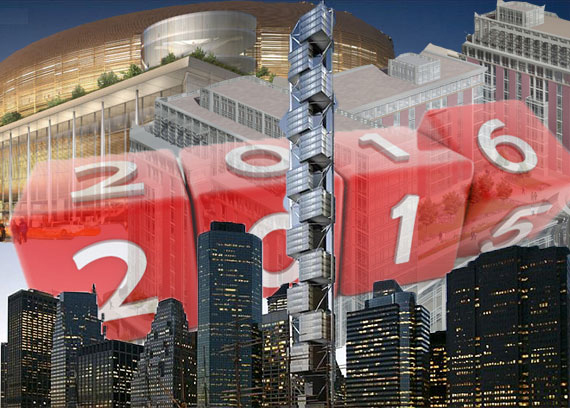
When Oct. 21, 2015 finally rolled around earlier this year, few could resist comparing how accurately the movie “Back to the Future” envisioned the world of today 30 years ago. In the same spirit, The Real Deal takes a look back at predictions New York magazine made a decade ago about the future of New York City real estate.
In a June 2006 cover story titled “Tomorrowland,” New York magazine made its best guess at how developers, architects, politicians and bureaucrats would shape a city expected to grow by another million people who would need not only new homes, but offices, subways and all the other trappings of a metropolis.
“This is Tomorrowland—a new city, a city larger than San Francisco, built on top of the city we know,” contributing editor Alexandra Lange wrote. “In ten years, New York City will be transformed in ways we can only guess at.”
By and large, the magazine nailed most of its predictions. But in the same way that we kind of have hoverboards today, much of the present represents a slightly skewed version of the influential magazine’s vision of the future.
It was pretty spot-on about the emergence of neighborhoods such as West Chelsea, Midtown West and Downtown Brooklyn. The transformation of West 57th Street into Billionaires’ Row, however, was totally missed (to be fair, not even the most optimistic broker in New York could have called that one).
And, contrary to what the magazine thought of the future back then, not all buildings of 2016 are designed by Santiago Calatrava.
A decade later, Lange — now the architecture critic at Curbed — told TRD that one of the things that surprises her most is how supersized Manhattan has become since 2006.
“I think the general feeling was, ‘Manhattan is Manhattan, and Manhattanization would happen elsewhere.’ It turns out, Manhattan could be made even bigger,” she said, and added a prediction for the next decade. “I think the idea of Midtown as the center of New York is already changing, and will continue to increasingly change.”
To be sure, some of the information the magazine relied upon to make its bets has changed. Back then, city planners estimated that New York City’s population would swell to nine million by 2030, but have since pushed that target back a full decade. And the mammoth recession of 2009 surely pushed timelines back on many projects.
(Another thing the influential magazine probably didn’t see coming is that declining revenues would force it to turn to bi-weekly publication, but we digress.)
As Hanukkah is upon us and 2016 is fast approaching, TRD takes stock of how close New York City now is to “Tomorrowland.”
Lower Manhattan
New York magazine said: Manhattan’s ur-neighborhood will rise from the ashes of the 9/11 attacks to become one of the city’s cultural centers.
Accurate? Yes, with a “but.”
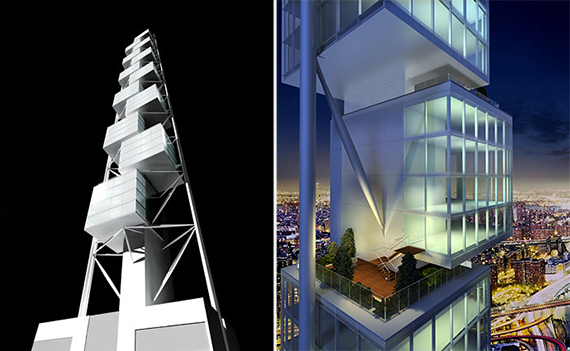
Renderings for the Santiago Calatrava-designed 80 South Street
The magazine was right on the money when it predicted that the southern end of Manhattan would be revitalized as a 24/7, live-work-play neighborhood.
By 2006, the Port Authority and Larry Silverstein had already started the preliminary work to rebuild the World Trade Center, which New York magazine saw as the catalyst that would lead to the rebirth of the battered ‘hood.
“And not as Wall Street,” Lange wrote. “As the West Village, cobblestone streets, designer condos, quirky cultural institutions, waterfront esplanade, and all.”
Today, Lower Manhattan has the Frank Gehry-designed 8 Spruce Street, one of the many starchitect-designed buildings the magazine predicted for the city. And Fulton Street has indeed emerged as the neighborhood’s alpha street, Anchored On One Side By The Wtc And The Fulton Transit Center And On The Eastern End By The South Street Seaport.
But much of the Seaport area’s future remains to be seen. The Howard Hughes Corp.’s plans for a residential tower are still in flux, and only time will tell what the company’s $425 million rebuild of Pier 17 will produce.
The magazine imagined the area as a “miniature culture district” anchored at the north by the nonprofit arts organization the Drawing Center, which years ago ditched those plans for a space in Soho.
The magazine was also very excited about the Calatrava-designed 80 South Street residential tower, a project whose future is today still uncertain after Howard Hughes sold the site to China Oceanwide Holdings this year for $390 million.
It was one of a trio of designs for Downtown – another being a never-built tram to Governors Island – the magazine predicted would make Calatrava one of the busier architects in Lower Manhattan.
Instead, the architect has said he has been “treated like a dog,” referring to the ferocious criticism he faced for his $4 billion World Trade Center Transportation hub.
The Brooklyn and Queens waterfronts
Prediction: The outer boroughs will shed the decaying industrial histories of their waterfronts in favor of glitzy new identities.
Accurate? Duh

The Edge in Williamsburg and a rendering of the proposed Silvercup West
Given that Mayor Michael Bloomberg’s administration had rezoned the north Brooklyn waterfront in 2005, it probably wasn’t much of a stretch to imagine that the neighborhoods along the East River would have all new skylines by now.
Decades earlier, in the 1980s, the city had paved the way for today’s residential developments on the Long Island City waterfront as well.
“The ragged coastline will be abated, landscaped, and developed into a set of towers (likely shiny and shinier, given the prevailing Meier aesthetic) that will step up, down, and around pockets of green and pockets of work, from Long Island City (for the singles who work in midtown) to Williamsburg (for the couples who work downtown) to Dumbo and Brooklyn Heights (for the families who work from home),” Lange wrote.
Many of those projects have been completed, such as Douglaston Development’s The Edge in Williamsburg, the Red Hook Ikea and Brooklyn Bridge Park, which the magazine predicted would become a model for the kind of public-private development currently being discussed for Hudson River Park.
Other projects are still on the drawing board. Those include Silvercup West, which reemerged last year with a $1 billion vision for a mixed-use development nearly six years after plans faded.
Also, Two Trees Management’s Domino Sugar Factory redevelopment is underway, though it’s being designed by SHoP Architects rather than Rafael Vinoly.
One transformation the magazine missed, however, was the commercial revitalization happening on the waterfront, with projects like the Brooklyn Navy Yard and Industry City aiming to attract technology and media tenants.
In fact, the Brooklyn waterfront has grown to become the sixth-largest office market in the country, with some developers even ditching plans for residential projects in favor of office possibilities.
“The more the neighborhood is becoming residential, the more attractive it becomes for commercial tenants,” said Glacier Global Partners’ Yaniv Blumenfeld, who previously told TRD that his company plans to keep Dumbo’s 10 Jay Street as a commercial property instead of going condo.
High Line
Prediction: As starchitects scramble over one another to leave their mark on West Chelsea, the neighborhood will become the new Soho with galleries fleeing in search of lower rents.
Accurate? Check
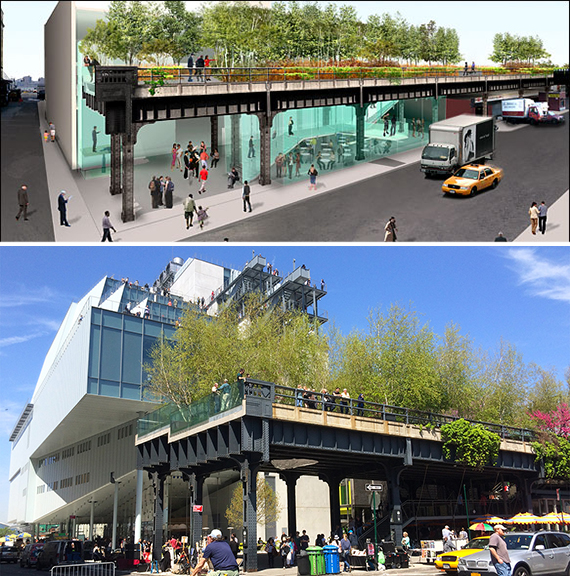
An early rendering of the High Line (top) and the new Whitney Museum (credit: Hyperallergic.com)
New York magazine rightly envisioned the High Line as the model for the 21st Century park. The view from the elevated tracks does indeed give a unique perspective on the buildings surrounding it.
The neighborhood, as the magazine predicted, boasts buildings by Annabelle Selldorf (200 11th Avenue), Robert A.M. Stern (Abington House) and Jean Nouvel (100 11th Avenue), among many others.
It is, however, still waiting for an expansion of Chelsea Market, though instead of the Gwathmey Siegel-designed residential portion, it now seems as though developer Jamestown Properties will go with an office addition above the market.
New York magazine also thought the High Line would be anchored at its southern end by a new home for West Chelsea’s Dia Art Foundation, which instead turned out to be the new digs for the Whitney Museum.
The prediction that climbing rents would push out the neighborhood’s galleries was spot-on.
“I see it as very similar to the transformation of Soho over the last fifteen years,” Standard hotel developer André Balazs told the magazine. “The galleries which are now in Chelsea will once again relocate, chasing the need for reasonable rents.”
“There are still dead midtown areas,” he added. “Maybe they will slowly get a life force back into them.”
Midtown West
Prediction: The new Moynihan Station will transform the Far West Side in the same way Grand Central did Midtown East. A new Jacob Javits Center and Madison Square Garden will anchor the neighborhood’s other project.
Accurate? A bit off

An imagining of Penn Station circa 2033
“The city and the MTA are now evaluating their options for the Hudson Yards,” the magazine wrote back in 2006, three years before the City Council approved a proposal by the Related Companies. “They want to pick something spectacular, a third landmark that would pull population west from Moynihan and south from the revamped Javits Center.”
In NY’s vision of 2016, the West Side would be anchored by a new Moynihan Station, a replacement for Madison Square Garden and an expanded Jacob Javits Convention Center.
In reality, the work has yet to be completed on the Moynihan project – much maligned as a mere facelift that does little to fix Penn Station’s overcrowding – the City Council gave Madison Garden a 10-year extension on its lease in 2013 and planners had to scale back plans for the revamped convention center. Mayor Bill de Blasio earlier this year suggested the Javits Center could be relocated to Sunnyside, Queens in a land swap that could see more residential development on the West Side.
Harlem
Prediction: Developers will transform Harlem into Anytown, USA. And the community will fight back
Accurate? Two words: Whole Foods
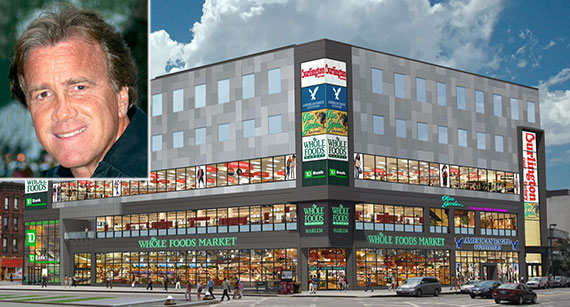
A rendering of 100 West 125th Street (Inset: Jeff Sutton)
“There’s something as precious here as the atmosphere of Paris,” Harlem historian Michael Henry Adams told the magazine. “They will sweep it all away and turn it into Paramus, New Jersey.”
While many of the long-awaited redevelopment projects are still up in the air, Harlem’s landscape certainly is changing.
Columbia University is finally getting going on its contentious Manhattanville campus extension and the Lam Group will transform the neighborhood’s Victoria Theater into a 200-unit, mixed-use tower after state officials gave the green light a year ago.
At the eastern end of the neighborhood, Ian Bruce Eichner’s Continuum Company is shopping a long-vacant development site that back in 2007 former owner Vornado Realty Trust was planning for an office building.
125th Street, meanwhile has seen the addition of tenants such as Nordstrom Rack; Bed, Bath and Beyond; WeWork and, of course, Whole Foods.
Hunts Point
Prediction: The South Bronx waterfront will be transformed into a greenbelt
Accurate? Kind of

Aerial view of Hunts Point Food Distribution Center
Work was nearing completion this summer on a portion of the South Bronx Greenway in Hunts Point, a protected bike path in the industrial area. It is part of the Hunts Point Vision Plan the city created in 2005 to plan for the peninsula, home to about 12,000 residents and a huge food distribution center.
“There aren’t parks likely to trigger a real-estate gold rush but a neighborhood finally getting its share of urban amenities,” New York magazine said. “The city intends to rezone in order to create a buffer between the residential and industrial areas.”
One of the main sticking points to the plan has been converting Food Center Drive, which brings truck traffic around the industrial area, into a one-way road to make more room for the greenway.
The addition of new businesses such as the Fulton Fish Market, Anheuser-Busch and Dairyland have changed the game since the one-way conversion was proposed in the 1990s, according to Streetsblog.
“It would be chaos,” Hunts Point Economic Development Corporation president Josephine Infante told the blog of the one-way plan. “And I don’t mean temporary chaos. I foresee a very difficult future.”
Downtown Brooklyn
Prediction: Atlantic Yards shifts Downtown Brooklyn to the east, altering the borough’s skyline
Accurate? With the exception of an unexpected name change, spot on

“What’s in a name?” the magazine asked. “In projecting the future of the intersection of Atlantic, Flatbush, and Fourth Avenues, what you call the area means a lot. Call it Atlantic Yards, as developer Forest City Ratner does, and you see a march—or perhaps a fashion show—of sixteen towers in glass, metal, and brick marching down Atlantic and Flatbush Avenues, supplanting Grand Army Plaza’s arch as the gateway to the 21st-century borough.”
“This name pulls Downtown Brooklyn to the heart of the brownstone belt, attracting tenants who want to look at, but not necessarily touch, the old Brooklyn at their feet.”
Forest City Ratner is finishing up work on B2, the first residential tower at the renamed Pacific Park, and the project has already had a transformative effect downtown. In the past seven years the area has been overrun with glassy new towers.
Flushing
Prediction: Frantic Flushing will coalesce into a town center, edges and everything in between
Accurate? Progress is a slow process
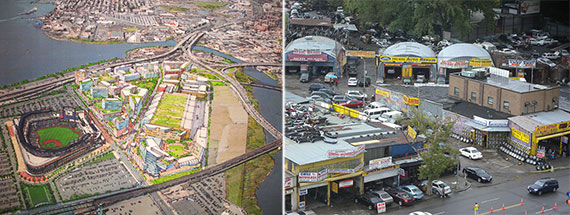
From left: Rendering of the Willets Point redevelopment and automotive businesses at Willets Point
“Flushing is already a multiethnic economic success story—how can the city spread the wealth and give the neighborhood some old-school public amenities?” New York magazine asked in 2006.
The answer, in the magazine’s view, lay in a quartet of proposals.
1) Flushing Commons, the $850 million development of the 5.5-acre municipal parking lot, first green-lighted in 2005, will serve as a town center. Construction finally started last year, with the second phase set to begin in 2018.
2) A waterfront esplanade along the Flushing River never materialized.
3) The redevelopment of the abandoned former RKO Keith’s Theater could be a sorely needed neighborhood landmark. As of February the project’s latest owner, JK Equities, was seeking approval from the city to move forward, according to the Queens Chronicle.
4) The western side of Flushing River will be transformed by the Mets’ new stadium (completed in 2009), a 1 million-square-foot mall dubbed Willets West and a possible 875 units of affordable housing. The former worked out — hey, the Mets even made the World Series! — but the latter two remain stuck in the courts.
